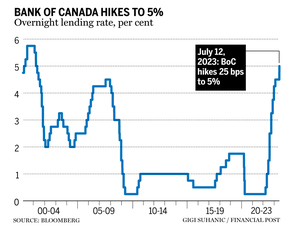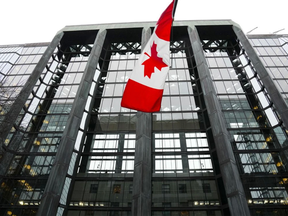Hawkish tone and stubborn inflation suggest central bank may not be done hiking rates yet
Article content
The Bank of Canada raised it benchmark lending rate 25 basis points to five per cent on July 12 , adopting what economists called a “hawkish tone” and reminding Canadians that bringing inflation back to the two per cent target remains its priority.
Advertisement 2
Article content
“The Bank remains resolute in its commitment to restoring price stability for Canadians,” it said in its statement.
Article content
Underpinning the bank’s decision were concerns about persistently strong domestic demand and an expanding labour market. It also pushed out its forecast for when inflation will return to target by six months into 2025.
“This shift in view may further help explain today’s decision, and the still-tough language,” said Douglas Porter, chief economist at BMO Economics.
So will there be another interest rate hike or is this the last in cycle?
Here’s what economists think the Bank of Canada will do next when it meets after the summer on Sept. 6.
Andrew Grantham, CIBC Economics
“The 25 basis point rise in the overnight rate to five per cent was broadly expected by the consensus and financial markets, and a continued hawkish tone within today’s statement suggests that risks are skewed towards another hike after the summer. However, after setting their forecasts for GDP growth quite low in prior MPRs (Monetary Policy Reports), the bar set in today’s updated forecast doesn’t seem quite as low. Quarterly growth is expected to be 1.5 per cent in both the second and third quarters, while full year growth rates of 1.8 per cent for 2023 and 1.2 per cent for 2024 are also above our current expectations. Because of this we think that there is scope for the economy to underperform the bank’s new forecasts and for the overnight rate to now remain on hold throughout the remainder of the year, despite the still hawkish tone of today’s statement.”
Advertisement 3
Article content
Stephen Brown, Capital Economics
“The Bank of Canada’s 25 basis point hike today, taking the policy rate to five per cent, is likely to be the last in this cycle. With the labour market loosening, core inflation declining and the survey indicators implying that inflation expectations are normalizing, we expect the Bank’s next move to be a rate cut – albeit not until 2024.
“Unlike in June, the decision to hike was correctly anticipated by the majority of forecasters and markets were pricing in an 80 per cent chance of the move. The accompanying policy statement did not provide any explicit forward guidance, but the tone was hawkish. It noted that “while the Bank expects consumer spending to slow in response to the cumulative increase in interest rates, recent retail trade and other data suggest more persistent excess demand in the economy”, while highlighting that strong immigration is initially putting upward pressure on activity and prices before any beneficial effect of reduced labour shortages is felt. Indeed, the Bank reiterated that “with three-month rates of core inflation running around 3.5 to four per cent since last September, underlying price pressures appear to be more persistent than anticipated.”
Article content
Advertisement 4
Article content
In terms of inflation at least, we think the bank is taking a glass half-empty approach. Its own surveys imply that capacity and labour shortages have now mostly returned to pre-pandemic norms, while inflation expectations have eased considerably and should continue to decline as actual inflation falls. Despite the Bank’s hawkish bias and continued concern that “that progress towards the two per cent target could stall”, we expect a further slowdown in GDP growth and evidence of easing core inflation to persuade the Bank to keep policy on hold over the rest of the year.
Joe Brusuelas, RSM Canada chief economist
“Our primary takeaway from the policy statement is that the Bank of Canada will likely lift its policy target by another 25 basis points to 5.25 per cent due to persistent inflation and a resilient economy that appears to be less sensitive to interest rate increases than it has been during previous business cycles.
Advertisement 5
Article content
“The statement pointed directly to robust demand and tight labour markets as the primary catalysts of persistent inflation. Although, domestic consumption will likely slow in response to the lagged impact of past rate hikes, strong demand from the external sector (United States) and a resilient domestic economy driven by immigration that underscores a solid housing market and overall economic activity.
“As base effects exit the inflation data improvements in pricing information will slow and it is clear that the BoC thinks that it will need to increase the policy rate at least one more time before any prospective peak in the current rate hike cycle can be declared.
“One key policy aspect to keep in mind is that participants in the real economy do not pay much attention to the short end of the curve. They look more at long term rates. If inflation proves persistent then the BoC may need to create the conditions for a steeper yield curve featuring higher long-term rates. Thus, an increase in quantitative tightening even as the central bank ends its rate hike cycle to push inflation back towards target may be necessary.
Advertisement 6
Article content
“Stay tuned. Even as the current rate hike cycle approaches its denouement the drama inside the central bank is not anywhere near over.”

Charles St-Arnaud, Alberta Central
“The key message in today’s decision is that the BoC is concerned by the persistence of both excess demand in the economy, with continued strong domestic demand and a tight labour market despite the significant monetary tightening since early 2022. As a result, core inflation is proving more persistent than the BoC had expected, supporting the BoC’s decision to tighten monetary policy further.
“We also believe that concerns regarding its reputation may also be playing a role in tilting the balance toward further hikes. The BoC has been under intense scrutiny and criticism for having left interest rates too low for too long during the recovery from the pandemic and being partly responsible for the current high inflation. By acting aggressively, the Bank is likely trying to restore its credibility as an inflation fighter and influence inflation expectations. As a result, the BoC likely prefers to do too much, rather than not enough.
Advertisement 7
Article content
“While the Boc does not provide any forward guidance on whether further rate hikes could be necessary, suggesting that the BoC will be data-dependant. Nevertheless, it is clear that if there were a tug-of-war between economic activity and fighting inflation, the BoC would choose the fight against inflation. With this in mind, while we believe that the BoC is likely on the sideline for the rest of the year, further rate increases this year cannot be ruled out. They would depend on the evolution of inflationary pressures and whether excess demand remains persistent.”
-

Bank of Canada hikes interest rate to 5%
-

Financial pressure building on several fronts for Canadians
-

How another Bank of Canada rate hike will affect the housing market
Advertisement 8
Article content
Douglas Porter, BMO Economics
“Today’s move can be characterized as a moderately hawkish hike, in that the BoC is certainly not closing the door on the possibility of further moves. The Bank remains above consensus on their growth call, and frankly they have been mostly right on that view this year. But, in conjunction with the surprising resiliency of the economy, the Bank is also still quite concerned about persistent underlying inflation. Perhaps the most telling comment in the statement: “Governing Council remains concerned that progress towards the 2 per cent target could stall, jeopardizing the return to price stability”. While we are not looking for further hikes this year, we are tweaking our rate call in light of the Bank’s view on growth and inflation — we now see rate cuts beginning only in the second quarter of 2024, one quarter later than our prior view.”
Advertisement 9
Article content
Jay Zhao-Murray, currency analyst, Monex Canada
“While we were more optimistic than the market on the prospect of hikes in June and July, we now think that markets have overpriced the risk of a third follow-up hike. Between now and September, we expect to see a gradual slowdown in the momentum of the Canadian economy over several months of data, helped by a slowdown in the U.S. as well, which will likely allow officials to stand pat at five per cent this year before beginning to ease policy in the first half of next year. Regardless of whether the BoC delivers the hike the market expects or not, Macklem’s comment that “we think we’re close” to getting inflation back to target is a clear sign that the tightening cycle is nearly over.”
Advertisement 10
Article content
Nathan Janzen, RBC Economics
“Governor (Tiff) Macklem reiterated in today’s press conference the BoC will need to increasingly balance the risk between over and under-hiking. Our own outlook is a more pessimistic one than the central bank’s. We see more signs that the economic backdrop is softening as the unemployment rate edges higher, inflation expectations trend lower and intensity of labour shortages ease (according to the last Business Outlook Survey). That should be enough to push the BoC back on the sidelines with no additional interest rate increases this year. But they are clearly willing to hike again at the next decision in September if inflation in particular doesn’t show further signs of easing.”\
Advertisement 11
Article content

Michael Davenport, Oxford Economics
“Our baseline forecast is much weaker than the BoC’s. We expect a moderate recession to get underway in Q3 2023 and last until Q1 2024 as the full impact of past interest rate hikes materializes, the correction in the housing market resumes, and the U.S. slips into recession in Q4. Accordingly, we forecast GDP growth of just one per cent in 2023, before a 0.2 per cent contraction in 2024. We think an imminent recession will create slack in the economy and help return inflation to the two per cent target range by Q3 2024 — about a year sooner than the BoC’s forecast. Given this outlook, we think the Bank will now hold rates steady until mid-2024, before gradually easing the policy rate to a neutral level once convinced that inflation will return to its two per cent target.”
Advertisement 12
Article content
Stephane Lavoie, Laurentian Bank Economics
“There is obviously no clear answer to when the monetary policy tightening journey will end. The BoC may have to hike again this fall. The open-ended last paragraph on today’s statement resembles the June 7 statement. The prudent data dependent approach of reacting to future near term economic developments makes sense. This way, the Bank of Canada avoids going back to the conditional pause strategy of last January that did not prevent markets to price in aggressive rate cuts and fuelled along the way resale housing activity during the spring. Resale transactions dipped in Toronto, Vancouver and Montreal during the month of June when the BoC resumed its tightening effort. Today’s message will contribute to keep potential homebuyers on the sidelines.”
Advertisement 13
Article content
Rishi Sondhi, TD Economics
“Today’s rate hike demonstrates that the Bank of Canada is not satisfied with the modest cooling in inflation and wage pressures that has been seen since its June hike. As it outlined in the statement, it’s concerned about excess demand and core inflation that are proving to be more persistent than what policymakers had expected.
“So, where does policy go from here? The onus is on the incoming data, which we think will show enough weakness over the coming months for policymakers to remain on hold for the next few quarters. We’re already seeing signs that job markets are softening, with vacancies well below prior peaks, the unemployment rate on the rise, wage growth beginning to moderate.”
Advertisement 14
Article content
Taylor Schleich, Warren Lovely & Alexandra Ducharm, National Bank of Canada Economics
“After the BoC resumed their tightening cycle in June, it seemed inevitable (barring a rapid and significant economic deterioration) that another hike would be in the offing. After all, if policy wasn’t deemed restrictive enough at 4.5 per cent, why would a meagre 25 additional basis points meaningfully change things? The BoC’s rate increase today offers support to that interpretation but the outlook for the policy rate becomes a bit murkier from here. Having quickly tightened another 50 basis points to a 22-year high of fiver per cent, there’s a more compelling case that the BoC should take some time to assess how tighter policy is impacting the economy. However, this wasn’t the ‘dovish hike’ that some had anticipated, as the BoC isn’t really guiding us there. Rather, policymakers retained a hiking bias, implicitly in the statement and explicitly in the press conference. Nonetheless, we’d stress that a September hike is not a forgone conclusion, and we think the BoC will be fully data dependent over the next two months. That was a message Governor (Tiff) Macklem clearly conveyed in the subsequent press conference.”
Advertisement 15
Article content
Randall Bartlett, Desjardins Financial
But the Bank made clear throughout the MPR (July Monetary Policy Report released alongside the rate decision) that it sees higher interest rates as the cure for these drivers of excess demand. So, looking to the next meeting in September, the door isn’t shut to another rate hike. That said, we continue to believe that this will be the final rate hike for this cycle, since the Bank of Canada’s quantitative tightening program will continue to tighten financial conditions even absent any more rate increases.”
• Email: gmvsuhanic@postmedia.com | Twitter: GSuhanic
Article content
More Bank of Canada rate hikes possible: economists
2023-07-12 16:16:20







Comments
Postmedia is committed to maintaining a lively but civil forum for discussion and encourage all readers to share their views on our articles. Comments may take up to an hour for moderation before appearing on the site. We ask you to keep your comments relevant and respectful. We have enabled email notifications—you will now receive an email if you receive a reply to your comment, there is an update to a comment thread you follow or if a user you follow comments. Visit our Community Guidelines for more information and details on how to adjust your email settings.
Join the Conversation